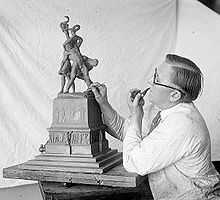Peter David Edstrom

Peter David Edstrom (a.k.a. Pehr David Emanuel Edstrom and David Edstrom) (March 27, 1873 – August 12, 1938) was an American sculptor.
Background
Edstrom was an immigrant from Vetlanda, Jönköping County, Sweden. In 1880, he immigrated to the United States with his parents, John Peter Edstrom and Charlotte Gustavson Edstrom. Edstrom lived in Ottumwa, Iowa from 1882 to 1894, which he embraced as his hometown and where he became aware of his artistic skills. (Des Moines Register; May 20, 2007). He returned to Sweden after a hobo's journey started in a freight train car on July 29, 1894 and ended (after a wage earner's trip across the Atlantic) in Stockholm where he supported himself during his studies at the Stockholm's Royal Institute of Technology and Royal Swedish Academy of Arts.
Career
In 1900, Edstrom moved to Florence where he attended the Academia of Fine Arts. In Florence, he created the sculptures Caliban (1900), Sphinx (1900), Lucifer (1902), The Cry of Poverty (1903), Despair (1904), and Pride (1904). (American National Biography). Edstrom also spent time in Paris, and became a member of the Gertrude Stein circle, appeared in some of Stein's word portraits, and sculpted the likeness of Harriet Lane Levy (the friend who brought Alice B. Toklas to Paris in 1907).
Edstrom returned to the United States in 1915. In about 1918, he designed one of his main achievements. The Soldiers and Sailors Monument in Ottumwa, featuring four reliefs on a shaft topped with a large eagle. Around 1920, he located in Los Angeles, where he was one of the organizers of the Los Angeles County Museum of Art. (McGurrin, 1964), (DMRegister, 2007)
In 1937, his autobiography, Testament of Caliban, was published, a biography which Rupert Hughes in his forward to the book "aver[ed]" Edstrom's self-story to be "garrulous and preposterous in its account of a man of huge appetites and colossal conceptions." (Kellner, 1988, p. 183). Edstrom died in Los Angeles, after two marriages: "one to the daughter of a Swedish official, who wore men's attire"; and another to Cora Downer, who Gertrude Stein described as the bride of "the fat Swedish sculptor who married the head of the Christian Science Church in Paris and destroyed her." (Ibid.)
Secondary sources
- Brigham, Gertrude Richardson, The Story of David Edstrom (referenced in Who's Who Among North American Authors, Golden Syndicate Pub. Co., Los Angeles, 1921) Google Books
- Hildebrand, Carver Edstrom. David Edstrom, Swedish American Sculptor (Swedish American Genealogist, 10, 1: 17-29. March, 1990)
- Kellner, Bruce, ed. A Gertrude Stein Companion: Content with the Example (New York, Westport, Connecticut, London: Greenwood Press, 1988) ISBN 0-313-25078-2.
- Lundén, Rolf, The Rise and Fall of a Swedish-American Sculptor: The Case of David Edström (The Swedish-American Historical Quarterly 54 (3) July 2003: 145-63)
- Swanson, Mary Towley, A Tangled Web: Swedish Immigrant Artists Patronage Systems, 1880-1940 (St. Thomas University 2004) Chapter 2 (pp. 11-12); Chapter 4 (pp. 8, 9, 14, 21 n.27)
External links
- Papers of David Edstrom (University of Iowa).
- Oral History Transcript; Smithsonian Archives of American Art Interview with Buckley MacGurrin (June 20, 1964).
- Brown University (biographical summary and images of four representative sculptures).